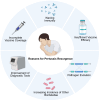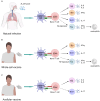Pertussis resurgence: epidemiological trends, pathogenic mechanisms, and preventive strategies
- PMID: 40709171
- PMCID: PMC12287121
- DOI: 10.3389/fimmu.2025.1618883
Pertussis resurgence: epidemiological trends, pathogenic mechanisms, and preventive strategies
Abstract
Pertussis, also known as whooping cough, is a highly contagious acute respiratory infection primarily caused by Bordetella pertussis. Although this disease can occur at any age, infants and young children remain the most vulnerable to severe illness and mortality. Moreover, epidemiological trends indicate a notable shift in the incidence of pertussis over time, with an increasing number of reported cases in adolescents and adults. During the 1950s, the widespread implementation of whole-cell pertussis (wP) vaccines significantly reduced the incidence and mortality associated with pertussis. Despite their effectiveness, the frequent adverse reactions linked to wP vaccines prompted a shift towards the utilization of acellular pertussis (aP) vaccines, which have a lower reactogenicity. However, over the past two decades, several countries with a high coverage of aP vaccines have experienced a notable rise in the incidence of pertussis, a phenomenon called pertussis resurgence. The causes of this resurgence are multifactorial and highly complex. Notably, the peak incidence of pertussis has shifted from the infant population to adolescents and adults, who now serve as the primary sources of infection in infants. Such a shift raises critical concerns regarding the current and future control of pertussis. The lack of comprehensive understanding of its pathogenesis is a significant contributing factor to this public health challenge. Although extensive research on the pathogenesis of pertussis has been conducted, it remains an issue without appropriate animal models that effectively replicate the symptomatology commonly observed in human cases. This review provides an overview of B. pertussis epidemiology and recent pathogenesis advances. It further analyzes the potential causes and contributing elements responsible for the resurgence of pertussis. Lastly, the review proposes evidence-based strategies aimed at enhancing public awareness and implementing effective measures to prevent the risk of unexpected outbreaks.
Keywords: Bordetella pertussis; epidemiology; pathogenic mechanisms; pertussis resurgence; preventive strategies; vaccines; waning immunity.
Copyright © 2025 Sheng, Ma, Zhou and Xu.
Conflict of interest statement
The authors declare that the research was conducted in the absence of any commercial or financial relationships that could be construed as a potential conflict of interest.
Figures





Similar articles
-
Pertactin deficiency of Bordetella pertussis: Insights into epidemiology, and perspectives on surveillance and public health impact.Hum Vaccin Immunother. 2024 Dec 31;20(1):2435134. doi: 10.1080/21645515.2024.2435134. Epub 2024 Dec 17. Hum Vaccin Immunother. 2024. PMID: 39686838 Free PMC article.
-
Acellular vaccines for preventing whooping cough in children.Cochrane Database Syst Rev. 2014 Sep 17;2014(9):CD001478. doi: 10.1002/14651858.CD001478.pub6. Cochrane Database Syst Rev. 2014. PMID: 25228233 Free PMC article.
-
Acellular vaccines for preventing whooping cough in children.Cochrane Database Syst Rev. 2012 Mar 14;(3):CD001478. doi: 10.1002/14651858.CD001478.pub5. Cochrane Database Syst Rev. 2012. Update in: Cochrane Database Syst Rev. 2014 Sep 17;(9):CD001478. doi: 10.1002/14651858.CD001478.pub6. PMID: 22419280 Updated.
-
The effect of pertussis vaccination in pregnancy on the immunogenicity of acellular or whole-cell pertussis vaccination in Gambian infants (GaPS): a single-centre, randomised, controlled, double-blind, phase 4 trial.Lancet Infect Dis. 2025 Aug;25(8):909-924. doi: 10.1016/S1473-3099(25)00072-6. Epub 2025 Mar 25. Lancet Infect Dis. 2025. PMID: 40154521 Clinical Trial.
-
Adaptive immune response to bordetella pertussis during vaccination and infection: emerging perspectives and unanswered questions.Expert Rev Vaccines. 2024 Jan-Dec;23(1):705-714. doi: 10.1080/14760584.2024.2383745. Epub 2024 Jul 24. Expert Rev Vaccines. 2024. PMID: 39037200 Free PMC article. Review.
References
Publication types
MeSH terms
Substances
LinkOut - more resources
Full Text Sources
Medical
Miscellaneous

